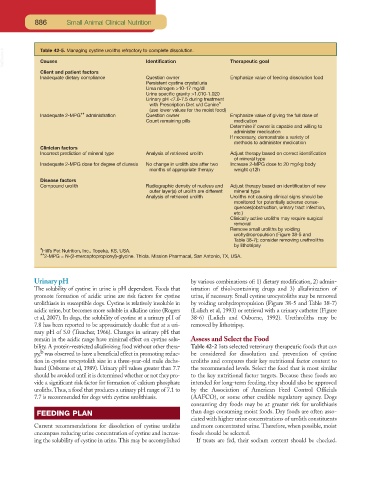Page 855 - Small Animal Clinical Nutrition 5th Edition
P. 855
886 Small Animal Clinical Nutrition
VetBooks.ir Table 42-5. Managing cystine uroliths refractory to complete dissolution. Therapeutic goal
Identification
Causes
Client and patient factors
Inadequate dietary compliance Question owner Emphasize value of feeding dissolution food
Persistent cystine crystalluria
Urea nitrogen >10-17 mg/dl
Urine specific gravity >1.010-1.020
Urinary pH <7.0-7.5 during treatment
with Prescription Diet u/d Canine*
(use lower values for the moist food)
Inadequate 2-MPG** administration Question owner Emphasize value of giving the full dose of
Count remaining pills medication
Determine if owner is capable and willing to
administer medication
If necessary, demonstrate a variety of
methods to administer medication
Clinician factors
Incorrect prediction of mineral type Analysis of retrieved urolith Adjust therapy based on correct identification
of mineral type
Inadequate 2-MPG dose for degree of diuresis No change in urolith size after two Increase 2-MPG dose to 20 mg/kg body
months of appropriate therapy weight q12h
Disease factors
Compound urolith Radiographic density of nucleus and Adjust therapy based on identification of new
outer layer(s) of urolith are different mineral type
Analysis of retrieved urolith Uroliths not causing clinical signs should be
monitored for potentially adverse conse-
quences(obstruction, urinary tract infection,
etc.)
Clinically active uroliths may require surgical
removal
Remove small uroliths by voiding
urohydropropulsion (Figure 38-5 and
Table 38-7); consider removing urethroliths
by lithotripsy
*Hill’s Pet Nutrition, Inc., Topeka, KS, USA.
**2-MPG = N-(2-mercaptopropionyl)-glycine. Thiola. Mission Pharmacal, San Antonio, TX, USA.
Urinary pH by various combinations of: 1) dietary modification, 2) admin-
The solubility of cystine in urine is pH dependent. Foods that istration of thiol-containing drugs and 3) alkalinization of
promote formation of acidic urine are risk factors for cystine urine, if necessary. Small cystine urocystoliths may be removed
urolithiasis in susceptible dogs. Cystine is relatively insoluble in by voiding urohydropropulsion (Figure 38-5 and Table 38-7)
acidic urine, but becomes more soluble in alkaline urine (Rogers (Lulich et al, 1993) or retrieval with a urinary catheter (Figure
et al, 2007). In dogs, the solubility of cystine at a urinary pH of 38-6) (Lulich and Osborne, 1992). Urethroliths may be
7.8 has been reported to be approximately double that at a uri- removed by lithotripsy.
nary pH of 5.0 (Treacher, 1966). Changes in urinary pH that
remain in the acidic range have minimal effect on cystine solu- Assess and Select the Food
bility. A protein-restricted alkalinizing food without other thera- Table 42-2 lists selected veterinary therapeutic foods that can
b
py, was observed to have a beneficial effect in promoting reduc- be considered for dissolution and prevention of cystine
tion in cystine urocystolith size in a three-year-old male dachs- uroliths and compares their key nutritional factor content to
hund (Osborne et al, 1989). Urinary pH values greater than 7.7 the recommended levels. Select the food that is most similar
should be avoided until it is determined whether or not they pro- to the key nutritional factor targets. Because these foods are
vide a significant risk factor for formation of calcium phosphate intended for long-term feeding, they should also be approved
uroliths.Thus, a food that produces a urinary pH range of 7.1 to by the Association of American Feed Control Officials
7.7 is recommended for dogs with cystine urolithiasis. (AAFCO), or some other credible regulatory agency. Dogs
consuming dry foods may be at greater risk for urolithiasis
FEEDING PLAN than dogs consuming moist foods. Dry foods are often asso-
ciated with higher urine concentrations of urolith constituents
Current recommendations for dissolution of cystine uroliths and more concentrated urine.Therefore, when possible, moist
encompass reducing urine concentration of cystine and increas- foods should be selected.
ing the solubility of cystine in urine.This may be accomplished If treats are fed, their sodium content should be checked.

